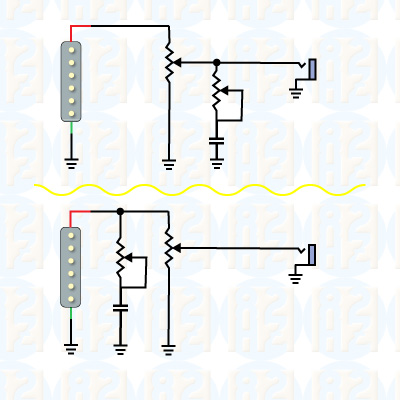Guitar wiring basics, part two
This is part two of a planned two-part, and now three-part series on basic guitar wiring concepts. This was going to be a brief side journey into tone controls. But even with the limited scope that is being discussed, it grew into its own page.
Just like part one, this will not cover specific guitars or the details of how pickups and volume controls work. It is intended to fill in for what I found to be some missing areas in the many websites that talk about guitar electronics.
Tonacious Details (with apologies to Jack Black)
There are a lot of possible things you can do with active tone controls. Active contols require a battery and a fair amount of extra circuitry to provide that flexibility. Passive tone controls, which are what is covered here, tend to do only one thing. That one thing is to remove the highs, or treble frequencies.
Passive controls
Guitar tone controls are generally simple "RC networks", which means a capacitor (cap) and a potentiometer (pot). Often the potentiometer is the exact same type that is used for the volume control.
Capacitors allow the higher frequencies to pass through them while they attenuate the lower frequencies. Exactly which frequencies go through and how much they are attenuated depends chiefly on the resistance of the adjacent circuits.
A lot of what you hear a tone control do depends just on the value of the cap and the value of the tone control pot. What really happens is much more complicated and depends on the pickups, the number of pickups being used, the level of the volume control or controls, the length of the cable that connects to the amplifier and a whole bunch of other stuff.
Let's use that RC circuit now.
Fifties vs. modern connections
There are two circuits that are commonly used as tone controls. They are often referred to as either the "50s" or "modern" type of controls.

The difference is whether the RC network is attached before or after the volume control. Figure 5 shows the 50s wiring in the top half and the modern wiring on the bottom.
In both cases, what the RC network is doing is allowing some high frequencies to pass through it. One end of the RC circuit is connecteded to ground, just like the volume control. And just like the volume control, when the resistance is high, its effect is minimized. When the tone is having its maximum effect, the pot's resistance is zero; the cap is essentially connected to ground and it is trying to send all of the high frequencies to ground. What remains are the low frequencies that you hear.
Because it's more complicated than that, some high frequencies are still heard. If you listen carefully you'll notice that changing the guitar's volume also changes the tone. It's more noticeable when the tone control is set to a midway point instead of either extreme. Sometimes another capacitor is added to try to minimize this effect, and there are at least three common ways to attack that issue. You can see how trying to describe these variations can quickly become a book. And that is probably why a lot of sites focus on specific guitars: there are fewer things to discuss.
RC networks
For those of you that aren't familiar with how the RC network electronics works:
- The RC network is the pot and the cap that are connected to each other.
- It doesn't matter which one, the pot or the cap, is connected to ground and which is connected to the signal side.
- Of the three (typical) connections on the pot, it doesn't matter which side the center terminal is connected to. What that affects is the direction in which the tone control is turned in order to change the tone.
More tone
But wait, there's more! If you order now you can get two RC circuits!
Yes, there is a choice on how many tone controls to use. The same concept applies to "50s" or "modern" tone hookups.
In part one, we covered how a switch is used to select between two pickups (or in some cases, select both). There was an option to use one volume control, which went after the switch. Another option was to use a volume control on each pickup, before the switch. Many guitars that have two volume controls will also have two tone controls, one for each volume control. It doesn't have to be that way — there could be one tone and two volume or vice versa.

Wrap-up
This was going to be just a two part series, but the tone control took more space than I expected. For part three, we'll be covering some more options about wiring humbuckers and how 3-way and 5-way switches work.


